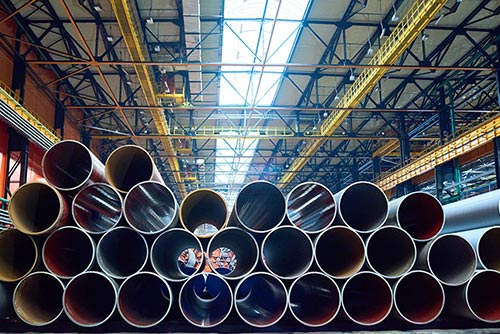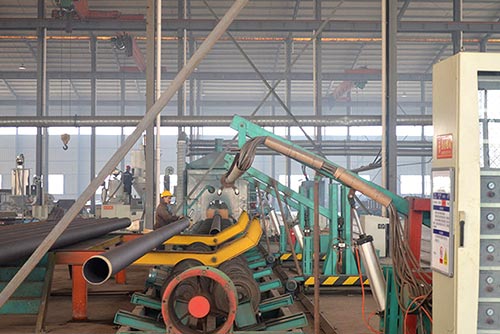Applications of flanges
- Categories:Product Information
- Author:Zhongran
- Source:Hebei Zhongran Pipeline Co., Ltd.
- Updated:2020-09-12
- Views:752
【Summary Description】
Applications of flanges
【概要描述】
- Categories:Product Information
- Author:Zhongran
- Source:Hebei Zhongran Pipeline Co., Ltd.
- Updated:2020-09-12
- Views:752
Applications of flanges
In many applications, engineers need to find a way to close off a chamber or cylinder in a very secure fashion, usually because the substance inside must differ from the substance outside in composition or pressure.
They do this by fastening two pieces of metal or other material together with a circle of bolts on a lip. This “l(fā)ip” is a flange.
Plumbing
You can connect two sections of metal piping by soldering or welding them together, but pipes connected in this way are very susceptible to bursting at high pressures. A way of connecting two sections of pipe more securely is by having flanged ends that you can connect with bolts. This way, even if gases or liquids build up to high pressures inside the pipe, it will often hold with no problem.
Mechanics
In order to connect two sections of a large, enclosed area, it is often best to used flanges and bolts. An example of this is the connection between the engine and the transmission in an automobile. In this case, both the engine and the transmission contain a number of moving parts that can easily get damaged if they get dust or other small objects inside of them. By connecting the outer casings of the engine and transmission in this way, engineers protect the inner workings of both.
Electronics
Flanges have a specific purpose in cameras and other electronic devices. Though flanges in such items do not usually have to sustain high pressures, they do have to hold tight so they can keep out harmful particles. These flanges are usually found connecting two different materials, such as the glass of a lens and the rest of the body of the camera.
Applications of ANSI Long Weld Neck Flanges
Applications involving high pressure and the need for a hub that is long and tapered are what weld neck flanges are most often used for. Specifying the schedule of pipe that it will be utilized for is of utmost importance when ordering. This type of flange is excellent for use in environments involving extreme temperature fluctuations and excessive handling and bending.
Uses for Long Weld Neck Flanges
The uses for long weld neck flanges are predominantly on vessels where an extended neck is required. The uses for long weld neck flanges (LWN) are predominantly on vessels where an extended neck is required. This is deemed to be a specialty flange due to the protruding neck or hub, which acts as a boring extension.
The tapered neck aids in reducing the thickness of the steel and it then seems to be a pipe extension. Steel LWN flanges are chiefly utilized in the chemical and petroleum industries, as well as commercial and residential buildings that experience high levels of stress and temperatures that fluctuate.
The Two Types ofWelding Neck Flanges
There are two types of weld neck flanges, which are standard and long. Standard weld neck flanges are used in butt weld fittings. Long weld neck flanges are used with vessel nozzles and equipment. The flanges are created to match the pipe’s inside diameter or fitting. The reason why it is bored to match is because it reduces the corrosion and turbulence that takes place inside of the pipe.
Application ofSpectacle blinds
Spectacle Blinds are generally applied to permanently separating pipesystems, or just to connect with each other. A Spectacle Blind is a steel plate cut into two discs of a certain thickness.
|
SPECTACLE BLIND INOPEN POSITION 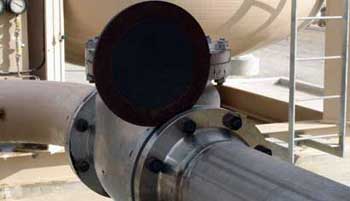 |
SPECTACLE BLIND INCLOSED POSITION 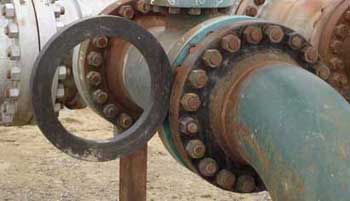 |
Spades and Ring Spacers are basically the same as Spectacle Blinds, except that both are not attached to each other.
Spades and Spacers be applied in systems where maintenance is often not necessary, or in applications with large pipe sizes. Depending on the flange size and the Pressure Class, Spades can weigh hundreds of pounds. To prevent unnecessary weight to a flange connections, usually will be chosen not for a Spectacle Blind, but for 2 separate parts.
RING SPACER
So as for the Spectacle Blind already described, maintenance on a pipesystem can be a reason to temporarily replace a Ring Spacer for a Spade. By loosening of all bolts, and half of the bolts temporarily remove, the Spade or Spacer can be placed. After replacing the gaskets (new gaskets are to recommend), the bolts can be re-assembled and tightened.
A small problem is that we basically can not see, or a Spade or a Spacer mounted between the flanges. Therefore the handles are often specially marked, or both have a different design; a customer often provides its own specification.
What should never lack is, that in the handle, the diameter and the Pressure Class of a Spade or Spacer is engraved; this applies also for the Spectacle Blind.
Surfaces - Dimensions - Material
The sealing surfaces of a Spectacle Blind, Spade or Ring Spacer are usually conducted in accordance with the Face Finish from the flange. The diameter always is slightly larger than the Raised Face of a flange; by a correct assembly, the bolts are just not touched by the Blind or Spacer.
The diameter of them, is depending on the flange size, and the thickness from the Pressure Class of a flange.
Dimensions from Spectacle Blinds, Spades and Ring Spacers, you will find in the main Menu "Flanges"
ASME B16.48 covers pressure-temperature ratings, materials, dimensions, dimensional tolerances, marking, and testing for operating line blanks in sizes NPS 1/2 - NPS 24 for installation between ASME B16.5 flanges in the 150, 300, 600, 900, 1500, and 2500 Pressure Classes.
Spectacle Blinds, Spades and Ring Spacers should be made from a plate or forging specification, approved for use by ASME B31.3, of essentially the same chemical composition as the mating flanges and piping involved.
What is the use of a blind flange?
BLIND FLANGE INCREATE A STOP
Blind flangeare put at the end of pipes or at the junction that would possibly be a future expansion into that direction.
BLIND FLANGE INBLOCK OFF A PIPELINE
A blind flange is a round plate which has all of the relevant blowholes except center hole, and because of this feature the blind flange is usually used to close off the ends of a piping systems and pressure vessel openings. It also permits easy access to the interior of a line or vessel once it has been sealed and must be reopened.
Often a blind flange is inserted into a pipeline when a repair is required further up the line. This allows the flanges down stream to be disconnected without fear of losing liquid. Many times this type of blockade is used when adding another line onto an existing pipeline or when a new valve is being added. This blockade is also used to shut down a line when it is no longer needed.
Materials for Flanges Based on Applications
Steel pipe flanges have a flat rib, collar or rim that is utilized for guiding or strengthening when attaching two pipes to each other. Materials, sizes and opening dimensions are varying based upon applications that the flanges are designed for and include threaded, socket-wired and slip-on styles.
Flanged connection
There are many ways to connect flanges, including threading, welding or bolting. The threaded flange is best for low pressure or smaller pipelines because it can maintain its seal. When your pipeline is larger or high pressure, then the welded flange is preferable. A boiler room is one place where welded blind flanges might be used, due to the high pressure involved.
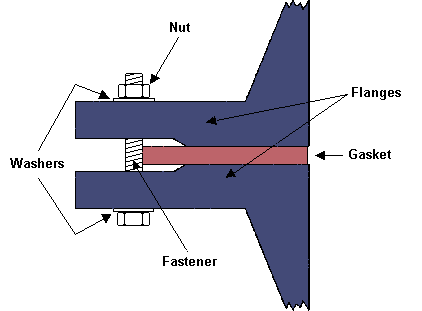
Flanged joints: flanges, bolts and nuts and gaskets
A flange is a external rib at the end of pipes, valves and other flow devices to assemble them.
Dimensions of the flanges are up to specific Standards : DIN, ANSI, AS, BS, JIS
A flanged connection requires two flanges (the "main" and the "companion"), a set of bolts and nuts (whose number depends on the flange diameter and class) and two sealing gaskets. Flanged connections have to be executed and supervised by trained personnel, as the quality of the joint has a critical impact on the performance of the piping system / pipeline (the standard TSE - TS EN 1591 Part 1-4, "Flanges and their joints", defines a number of requirements for the execution of proper flanged connections). Whereas all elements of the joint are critical, experience shows most leaks are originated by the improper installation of the sealing elements, i.e. the gaskets.
The typical pipe to flange connections are welded or threaded. Welded flanges are used for pipelines and piping systems with high pressures and temperatures, and with diameters above 2 inches.
Threaded connections are instead used for installations of smaller diameter and not subject to severe mechanical forces such as expansion, vibration, contraction, oscillation (forces that would crack the threaded joint). In all these critical cases, butt weld connections are recommended.
Type of face flanges
There are different flanges profiles.
Raised Face Flange RFRaised Face Flanges (RF):
RF flanges seal with a flat gasket designed for installation between the raised faces of two mating flanges (both with raised faces). The raised faces have a prescribed texture to increase their gripping and retaining force on this flat gasket. Some users of raised face flanges specify the use of spiral wound gaskets.
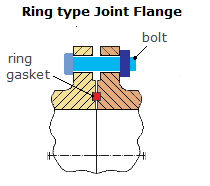
Ring Type Joint Face RTJRing Type Joint Flanges (RTJ) or Ring Joint Facing Flanges (R-JF):
RTJ flanges have grooves cut into their faces which accept steel Ring Gaskets. RTJ flanges seal when tightened bolts compress the gasket between the flanges into the grooves, deforming (or "Coining") the gasket to make Intimate Contact inside the grooves, creating a metal to metal seal.
An RTJ flange may have a raised face with a ring groove machined into it. This raised face does not serve as any part of the sealing means. For RTJ flanges that seal with BX ring gaskets, the raised faces of the connected and tightened flanges may contact each other. In this case the compressed gasket will not bear additional load beyond the bolt tension, vibration and movement cannot further crush the gasket and lessen the connecting tension.
Connection Types of Flanges
Connection types of flanges can generally be divided into five kinds: flat welding, butt welding, socket welding, loose and threaded.

Flange easy to use, able to withstand greater pressure. Below is the detailed description of first four kinds:
1. Flat welding:only for welding outer layer, welding inner layer is not required; normally, it often used in medium, low pressure pipes. Nominal pressure of pipe is lower than 2.5Mpa. Sealing surface of flat welding flanges has three kinds: smooth type, concave-convex type and tongue and groove type. Among them, smooth type is the most widely used with cost effective.
2. Butt welding:both outer and inner of flange need to be welded. Normally, it is widely used in medium and high pressure pipes. Nominal pressure of pipe is between: 0.25-2.5Mpa. Seal surface of connection type of butt welding flange is concave-convex type with complex installation. Therefore, cost of labor, installation method and auxiliary is a little high.
3. Socket welding:normally, it is used in the nominal pressure lower than 10.0 Mpa. Nominal diameter is lower or equal to 40mm of pipe.
4. Loose:normally used in the pipes with not high and its medium is a little corrosive. Therefore, this kinds of flange is corrosion resistant. The material is mainly stainless steel.
掃二維碼用手機(jī)看
- Telphone- 0317-6165555 6689999
- E-mail- 798758696@qq.com
- Address- Yanshan County Industrial Park, Cangzhou City, Hebei Province
- Telphone- 0317-6165555 6689999
- E-mail- 798758696@qq.com
- Address- Yanshan County Industrial Park, Cangzhou City, Hebei Province


